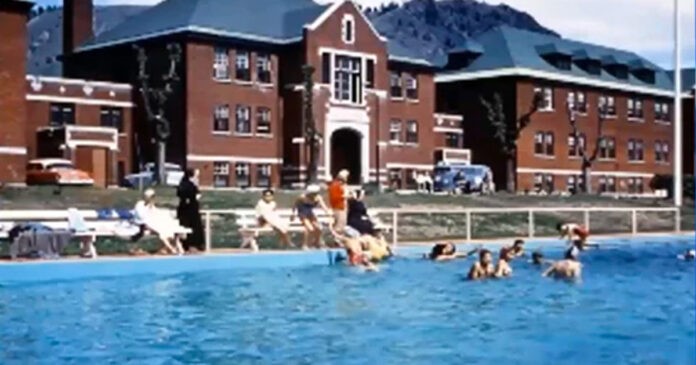The overwhelming majority of Canadians regret the history of European contact with Indigenous peoples, and the injustices and hardships that followed over the hundreds of years since. At the same time, they celebrate Canada’s accomplishments, which have created a Canada that is the envy of the world. New Canadians are more than glad to be here. Many generations of non-Indigenous Canadians have celebrated the toils, tribulations and successes of their settler ancestors, some of whom have resided here a dozen generations or more.
New Canadians have come in their millions – and still do – to share in the bounty that is Canada.
Then came May 27, 2021 when it was announced that there might be 215 bodies of children buried near the Kamloops Indian Residential School (KIRS), children who had attended the school there. Everything about the Canadian consciousness changed.
But should there have been such change?
For nearly 200 years Indigenous parents sent their children to Indian residential schools to learn to read, write, compute, and learn other skills to prepare them for life in the 19th and 20th centuries and beyond. Some of those children were orphans, some were neglected at home, some were abused at home. Some communities had no schools, and parents sent their children to residential schools because they wanted their children to be prepared for the future. Sometimes the schools were far away from the children’s homes, and the children admitted to the schools suffered loneliness and isolation. But many parents needed a place for their children while they hunted, fished, trapped and worked in the lumber industry. Traplines and hunting, fishing and lumber camps were not the best places to raise children as the modernization of the 20th century ground forward.
Many of the children had learned the English or French language before their admission to the schools. Many of them were already converted to Catholic or Protestant religions. Most applications for admission to the schools were signed by parents or guardians. The children were given medical examinations before their applications were approved by the government in Ottawa.
But in spite of all the efforts of the schools and the government to educate Indigenous children at Indian residential and day schools, by 1940 there were still about 40 percent of them not attending any school at all.
Boarding schools throughout the world were, in those earlier days, places of loneliness, and many still are. By today’s standards, the Indian schools were oppressive, unhappy places. Even if they were staffed largely by nuns and others who dedicated their lives to the welfare and education of young Indigenous Canadians, things happened that should not have happened. Some children were abused by people in authority who should never have been placed in their charge. Corporal punishment was common in most, if not all, schools in those days, and those operating the schools must have felt that the only way to prepare Indigenous kids for “modern” society was to treat them in the same way non-Indigenous kids were treated in other boarding school situations.
In hindsight, we know that approach was chequered. Governments, churches, First Nations leaders, Indigenous parents and others at the time did not know it was the wrong approach. They thought it was the only approach available in the changing times in which they lived. Parents wanted their children to be educated.
But so too was the approach to education everywhere else chequered, by today’s standards. Beginning in Ontario, school aged children were required by law (forced?) to attend schools since 1871. In public schools, all children, including immigrant children from various cultures and speaking various languages, were required to learn in English or French. Corporal punishment was used everywhere. For example, In the 1890s, when Canada’s Minister of the Interior, Sir Clifford Sifton, began inviting eastern Europeans to immigrate to Canada, Ukrainian students were strapped at their schools when they spoke their native language.
In earlier times, many western Canadians were farmers, rural people. Rural children went to one-room schoolhouses where one teacher’s class comprised children of all school ages. The schools’ construction quality was far below the standards of today. We take for granted today “necessities” like indoor plumbing, running water, electric lighting, quality ventilation in our homes, schools and public buildings. These comforts were often not available in those early days.
Death and disease were everywhere, especially in the early days: in schools, homes, reserve communities, towns and cities. Vaccines for smallpox, tuberculosis and other deadly diseases had not yet been developed, vaccines that in later years saved thousands of Indigenous and non-Indigenous lives.
Given the living conditions that existed on reserves, on traplines and at hunting, fishing and lumber camps, many Indigenous parents opted to send their children to residential schools where they were fed, clothed, educated and provided medical care. And roofs over their heads.
And given that times were changing, it was important to those parents that their children should be educated so that they could survive and, hopefully, thrive in the 20th century and beyond.
In hindsight today, we are certainly able to find fault with the Indian residential schools. It can safely be acknowledged that the churches and governments of the day were not sufficiently prepared to understand Indigenous cultures and traditions, how they differed from the European experience, and just how important they were to Indigenous Canadians.
But – rightly or wrongly – everyone agreed that education was key to the future of Indigenous peoples living in what became Canada. If that were not so, the provision of schools would not have been included in the numbered treaties, which were designed at the time to assist in the peaceful settlement and development of Canada’s west.
What should have been done? How should the Indigenous/European relationship spanning 500 years have been handled? How should the children have been educated? To date, nobody has answered those questions. That is because, quite likely, nobody knows. There have been dozens of studies and commissions of inquiry, thousands of consultations, numerous apologies, billions in compensation. Healing centres and crisis lines have been established. Funds have been committed to investigate allegations of abuse and crime, and to identify possible victims. Funding for Indigenous people and programs has been increased substantially, especially in recent years.
There have indeed been many policy changes and large amounts of additional funding over the years, but not to the satisfaction of a majority of the leaders of Canada’s more than 630 First Nations. All this has been accompanied by guilt, shame, recrimination, mistrust, protest, destruction – even hatred and loathing. And anyone questioning any part of the victim/oppressor narrative established so firmly in the Canadian consciousness is silenced by accusations of denialism and even racism.
Through their governments, Canadians have been taking significant steps to address the wrongs of the past. Popes, Cardinals, and other church representatives have been apologizing for the past 35 years. But for many Indigenous leaders and their activist associates, the apologies and other sincere actions taken are not enough. Demands continue, and increase. Recently, Pope Francis again apologized on behalf of his church. The Indigenous demands that followed included: more document disclosure; repatriation of Indigenous art and religious items, repudiation of the Doctrine of Discovery; extradition and prosecution of abusers; more compensation.
The Pope’s apology has also been faulted because it referred to the actions of individuals and not the church as a whole. Indigenous leaders have been scrambling to insist the feeble 85-year-old attend in person to many of their communities to deliver further apologies, their wording dictated by them, and on a timetable set by “survivors themselves.”
After twenty generations of native and “settler” Canadians’ endeavouring to figure out who we are, only a few have bravely said publicly, “Let’s move on and make Canada a better place for all of us.”
James C. McCrae is a former attorney general of Manitoba and former Canadian citizenship judge.



